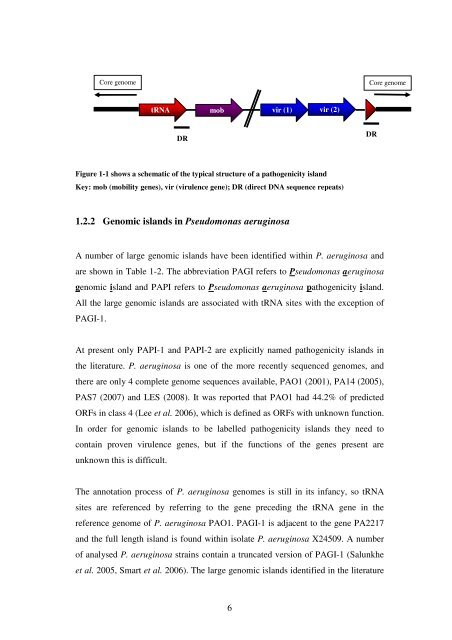5 The role of quorum-sensing in the virulence of Pseudomonas ...
5 The role of quorum-sensing in the virulence of Pseudomonas ...
5 The role of quorum-sensing in the virulence of Pseudomonas ...
You also want an ePaper? Increase the reach of your titles
YUMPU automatically turns print PDFs into web optimized ePapers that Google loves.
Figure 1-1 shows a schematic <strong>of</strong> <strong>the</strong> typical structure <strong>of</strong> a pathogenicity island<br />
Key: mob (mobility genes), vir (<strong>virulence</strong> gene); DR (direct DNA sequence repeats)<br />
1.2.2 Genomic islands <strong>in</strong> <strong>Pseudomonas</strong> aerug<strong>in</strong>osa<br />
A number <strong>of</strong> large genomic islands have been identified with<strong>in</strong> P. aerug<strong>in</strong>osa and<br />
are shown <strong>in</strong> Table 1-2. <strong>The</strong> abbreviation PAGI refers to <strong>Pseudomonas</strong> aerug<strong>in</strong>osa<br />
genomic island and PAPI refers to <strong>Pseudomonas</strong> aerug<strong>in</strong>osa pathogenicity island.<br />
All <strong>the</strong> large genomic islands are associated with tRNA sites with <strong>the</strong> exception <strong>of</strong><br />
PAGI-1.<br />
Core genome Core genome<br />
tRNA<br />
At present only PAPI-1 and PAPI-2 are explicitly named pathogenicity islands <strong>in</strong><br />
<strong>the</strong> literature. P. aerug<strong>in</strong>osa is one <strong>of</strong> <strong>the</strong> more recently sequenced genomes, and<br />
<strong>the</strong>re are only 4 complete genome sequences available, PAO1 (2001), PA14 (2005),<br />
PAS7 (2007) and LES (2008). It was reported that PAO1 had 44.2% <strong>of</strong> predicted<br />
ORFs <strong>in</strong> class 4 (Lee et al. 2006), which is def<strong>in</strong>ed as ORFs with unknown function.<br />
In order for genomic islands to be labelled pathogenicity islands <strong>the</strong>y need to<br />
conta<strong>in</strong> proven <strong>virulence</strong> genes, but if <strong>the</strong> functions <strong>of</strong> <strong>the</strong> genes present are<br />
unknown this is difficult.<br />
DR<br />
mob<br />
Figure 1-1<br />
<strong>The</strong> annotation process <strong>of</strong> P. aerug<strong>in</strong>osa genomes is still <strong>in</strong> its <strong>in</strong>fancy, so tRNA<br />
sites are referenced by referr<strong>in</strong>g to <strong>the</strong> gene preced<strong>in</strong>g <strong>the</strong> tRNA gene <strong>in</strong> <strong>the</strong><br />
reference genome <strong>of</strong> P. aerug<strong>in</strong>osa PAO1. PAGI-1 is adjacent to <strong>the</strong> gene PA2217<br />
and <strong>the</strong> full length island is found with<strong>in</strong> isolate P. aerug<strong>in</strong>osa X24509. A number<br />
<strong>of</strong> analysed P. aerug<strong>in</strong>osa stra<strong>in</strong>s conta<strong>in</strong> a truncated version <strong>of</strong> PAGI-1 (Salunkhe<br />
et al. 2005, Smart et al. 2006). <strong>The</strong> large genomic islands identified <strong>in</strong> <strong>the</strong> literature<br />
6<br />
vir (1)<br />
vir (2)<br />
DR














